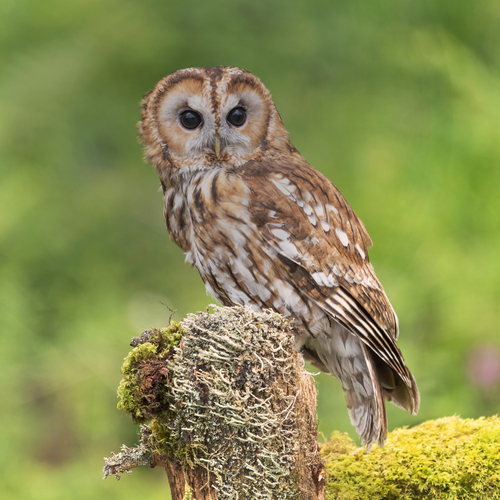
Tawny Owl
The Tawny Owl (*Strix aluco*) is a medium-sized, robust owl known for its distinctive hooting call, often associated with woodlands across Europe and parts of Asia. It plays a crucial ecological role as a top predator of small mammals, birds, and insects, helping to regulate their populations. While not typically considered a bird of significant cultural importance like some other owl species, its nocturnal habits and characteristic calls have made it a familiar, if often unseen, presence in folklore and literature, often symbolizing wisdom or mystery.
37-46 cm
Length
81-105 cm
Wingspan
Least Concern
Conservation Status
Distribution
The Tawny Owl is widely distributed across Europe, extending eastward into parts of Asia, including Russia, Siberia, and the Middle East. It is largely absent from Ireland and Iceland. Its range also includes parts of North Africa. It is generally non-migratory, remaining resident within its territory year-round.
Lifespan
Average lifespan in the wild is around 4-6 years, but some individuals have been recorded living over 18 years. In captivity, they can live longer, up to 20 years or more.
Tawny Owl's Habitat
Habitat Types
Deciduous woodlands, Mixed forests, Parks, Large gardens, Cemeteries, Coniferous forests (less preferred)
Climate Zones
Temperate, Boreal (southern edges), Mediterranean
Adaptations
Tawny Owls are adapted to woodland environments with dense tree cover for roosting and nesting. Their mottled brown plumage provides excellent camouflage against tree bark. Their forward-facing eyes provide excellent binocular vision, crucial for judging distances when hunting in low light. Their soft feathers allow for near-silent flight, enabling them to ambush prey.
Variations
Several subspecies of Tawny Owl are recognized, differing slightly in plumage color and size. For example, *Strix aluco aluco* is found in much of Europe, while *Strix aluco mauritanica* is found in North Africa and tends to be darker.
Appearance
Breeding Plumage
Tawny Owls do not have distinct breeding and non-breeding plumages. Their plumage remains relatively consistent throughout the year.
Seasonal Feather Changes
There is little seasonal variation, although plumage may appear slightly worn or faded before the annual moult.
Sex Based Plumage Differences
There is minimal sexual dimorphism in plumage, although females may have slightly warmer brown tones on average.
Notable Features
Rounded head with no ear tufts, Dark brown or black eyes, Mottled brown, grey, or reddish-brown plumage (different color morphs exist), Facial disc surrounding the eyes, aiding in sound localization
Diet and Feeding
Primary Foods
Small rodents (mice, voles, rats), Small birds, Insects, Earthworms, Amphibians (occasionally)
Foraging Behavior
Tawny Owls are primarily nocturnal hunters, using a 'sit-and-wait' strategy. They perch on a branch, listening and watching for prey, then swoop down silently to capture it with their sharp talons. They also occasionally hunt during the day, especially when feeding young.
Specializations
Their asymmetrical ear openings allow for precise sound localization, enabling them to pinpoint the location of prey even under leaf litter or snow. Their sharp talons and powerful grip are adapted for killing and carrying prey.
Seasonal Diet Variations
Diet varies slightly depending on prey availability. During winter, they may rely more heavily on rodents, while in spring and summer, they may consume more insects and young birds.
Behavior
Social Structure
Tawny Owls are generally solitary and territorial, except during the breeding season when they form pair bonds.
Communication
Male's hooting call (a two-part 'hoo-hoo'), Female's 'kee-wick' contact call, Bill snapping (used as a threat display), Various chittering and hissing sounds
Migration
Tawny Owls are non-migratory, remaining resident within their territories year-round. Young birds may disperse to find their own territories.
Territorial or Group Behaviors
Tawny Owls are highly territorial, defending their territories against intruders of the same species. Territories are maintained year-round and are often held by the same pair for many years.
Conservation
Threats
Habitat loss (loss of mature woodlands), Pesticide use (reducing prey populations), Collisions with vehicles, Secondary poisoning (from consuming poisoned rodents)
Protection Programs
Habitat preservation and restoration, Provision of nest boxes, Monitoring of populations, Awareness campaigns about the dangers of pesticides
Local National Laws
Protected under various national and international wildlife laws, such as the Wildlife and Countryside Act 1981 in the UK.
Population Trend
Stable
Population Estimates
The global population is estimated to be in the millions, with a large and stable population in Europe.
Interesting Facts
Tawny Owls have excellent night vision.
Their eyes are adapted for low-light conditions, with a high density of rod cells (responsible for light sensitivity).
They can rotate their heads up to 270 degrees.
This allows them to scan a wide area for prey without moving their bodies.
Tawny Owls swallow their prey whole.
They later regurgitate indigestible parts, such as bones and fur, in the form of pellets.
There are different color morphs of Tawny Owls
Ranging from grey to brown to rufous, which may be related to camouflage in different habitats.
Faqs about Tawny Owl
What is the call of a Tawny Owl?
The male Tawny Owl has a characteristic hooting call ('hoo-hoo'), while the female often makes a 'kee-wick' sound. They often call in duet.
Are Tawny Owls dangerous to humans?
Tawny Owls are not generally dangerous to humans. However, they may become aggressive if they feel their nest or young are threatened. *Consult a professional for expert advice.*
Do Tawny Owls mate for life?
Tawny Owls often form strong pair bonds and may remain together for many years, often for life, within the same territory.
Where can I see a Tawny Owl?
Tawny Owls are widespread in woodlands and parks across Europe and parts of Asia. While they are nocturnal, you may be lucky enough to spot one roosting during the day, or hear their calls at night.
Copyright @ Nature Style Limited. All Rights Reserved.
 English
English